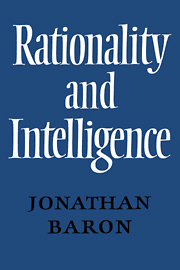Book contents
- Frontmatter
- Contents
- Preface
- 1 Introduction
- 2 Rational choices and plans
- 3 A theory of thinking
- 4 The scheme fleshed out: a decision–theoretic analysis of thinking
- 5 Conditions of effective thinking
- 6 Effects of rational thinking on the individual and society
- 7 The teaching of rational thinking
- References
- Index
4 - The scheme fleshed out: a decision–theoretic analysis of thinking
Published online by Cambridge University Press: 05 October 2009
- Frontmatter
- Contents
- Preface
- 1 Introduction
- 2 Rational choices and plans
- 3 A theory of thinking
- 4 The scheme fleshed out: a decision–theoretic analysis of thinking
- 5 Conditions of effective thinking
- 6 Effects of rational thinking on the individual and society
- 7 The teaching of rational thinking
- References
- Index
Summary
In the present chapter, I explore the possibility of interpreting the prescriptive scheme of chapter 3 in terms of some mathematical models. If we can fix (or assume, or measure) the utilities of a subject in a laboratory experiment, and if we can fix (or measure) various subjective probabilities or degrees of belief, we can prescribe his behavior in the experiment. By comparing his behavior to what we prescribe, we can find out whether he is performing optimally, and, if not, we can perform experiments to find out why not. In addition, these models may enlighten us about the interpretation of experiments that have already been reported.
I shall begin by considering some experiments that purport to show biases in the search for evidence, other than the kind of confirmation bias I discussed in chapter 3. I shall suggest that there are other interpretations of these experiments, in terms of other biases I have mentioned, some biases I have not mentioned yet, or no biases at all. This section of the chapter also lays out a general framework that will be useful in the rest (although it need not be understood in detail). In the rest of the chapter, I discuss the experimental study of the biases discussed in chapter 3: impulsiveness, confirmation bias, and belief perseverance.
- Type
- Chapter
- Information
- Rationality and Intelligence , pp. 130 - 167Publisher: Cambridge University PressPrint publication year: 1985
- 1
- Cited by



